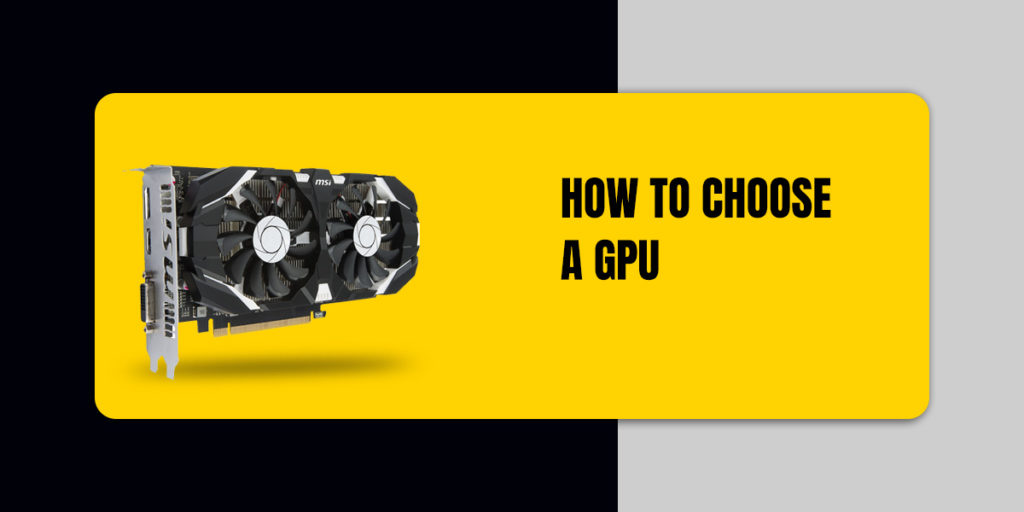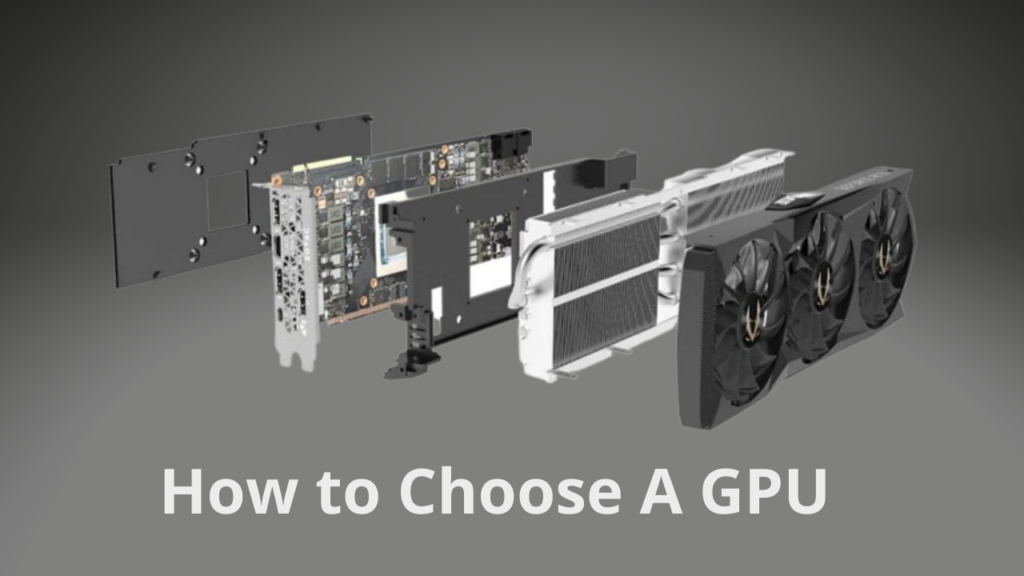Contents

Wanna know how to choose a GPU? Read further to know more.
If you are looking to buy a new Desktop or a new Laptop, then you need to choose the best GPU for your PC or laptop, the best GPU for you will depend on what you want to do with it.
If you’re a video game player or a 3D artist, a high-end gaming card might be the way to go. If you’re a gamer but you just want to run other programs at a high frame rate, then a mid-range gaming card is more suitable.
If you’re looking for a good value, then a low-cost, entry-level card will do the trick. But, if you’re a bit of a computer nerd, then you can always splurge a bit more money and go for a high-end, premium card.
What Is A GPU (Graphics Processing Unit)?
A GPU (Graphics Processing Unit) is a processor used mainly to display graphics in computers. However, it can also be used for other computations such as compression and transcoding.
Mainly, GPGPU (General-Purpose computing on Graphics Processing Units) is used in scientific and engineering applications. It allows scientists to perform calculations faster than traditional CPUs.
The other major use of GPU is in cryptocurrency mining. It is the main unit used for mining cryptocurrency. This is due to the fact that it is capable of performing millions of calculations in a second. This is what makes it the best for cryptocurrency mining.
The GPU, or graphics processing unit, handles all the visuals and can be a difference-maker depending on the game and system. GPUs are rated based on their processing speed, memory, and the number of calculations they can perform per second.
How To Buy A Gpu: Which Specs Matter And Which Don’t?
Graphics card memory amount: Get at least 8GB of memory if you plan to game at 1080p. You’ll need more memory if you play with all the settings turned up or you install high-resolution texture packs. And if you plan to game at very high resolutions such as 4K, more than 8GB is ideal.

Form factor: You’ll want a card that’s not too big, but not too small either. It should sit in a slot that’s easy to reach and remove. If you’re a bit of a PC nerd, then a dual-slot card might be perfect for you.
TDP: The thermal design power or TDP is a measurement of how much heat your graphics card is generating. If you plan on overclocking your GPU, then make sure that your PSU can handle the extra load.
Power Connectors: Some graphics cards have more than one power connector, and they can be located on either side of the card or even on the back of the card.
In addition to these power connectors, you’ll also want to make sure that your power supply has at least three other standard SATA/Molex power connectors.
If your power supply doesn’t have these, then you’ll need to upgrade—adapters that draw power from a couple of SATA or Molex connectors are not recommended as long-term solutions.
Ports: You’ll want a card that has at least one DisplayPort connector. If you plan on using HDMI, then make sure that your monitor supports it. If you’re not sure whether your monitor has DisplayPort or HDMI, then look up the specs on the manufacturer’s website or ask someone who knows.
Clock speed: Clock speed isn’t that important, however, as memory speed, core counts and architecture need to be factored in. Better cooling often trumps clock speed as well, on cards with the same GPU.
Memory speed/bandwidth: If you plan on playing a game such as World of Warcraft, then you’ll want a card that has at least 3GB of memory. If you’re planning on playing newer games, then make sure that your card has at least 8GB of memory.
Can It Support Vr?
You’ll need a mid-range, high-performance GPU if you want to use your PC with a headset, like the Oculus Go. The lowest-end cards you can use with these headsets are the AMD Radeon RX 570 and Nvidia GTX 1060.
The higher the resolution of the headset, the more powerful the GPU needs to be to output the appropriate graphics.
What About Ray Tracing And Ai?
As we’ve seen, the RTX 30-series is the best option for ray tracing. The RX 6000-series is very close but lacks DLSS. It’s missing the FidelityFX Super Resolution mode, which is AMD’s replacement for ray tracing support, and there aren’t many games that take advantage of ray tracing on the RX series.
Reference Card Or Third Party Design?
Even after you’ve decided what GPU you want, you’ll usually find that there are plenty of options in terms of coolers and brands.
Nvidia makes and sells its cards under the “Founders Edition” moniker for higher-end models, while AMD licenses its reference design to other manufacturers. Both companies’ GPUs appear in third-party cards from several different vendors.
There are many third-party cards available that cost a bit more than the reference card, but often come with elaborate coolers, extra fans, and often higher clock speeds.
The benefits of overclocking can sometimes be minimal (and even at higher resolutions the gain is often only a few frames per second), but bigger and more elaborate coolers can often translate into cooler and quieter operations.
Card Recommendations By Resolution / Use Case
Once you’ve reviewed all the above, and are ready to narrow down your choices, you can head to our GPU Benchmarks and our Best Graphics Cards to help finalize your buying decision.
Here we include a condensed version of our current favorite cards for common resolutions and gaming scenarios below.
Keep in mind that there are third-party options for all of these cards, so you may want to use these picks as a jumping-off point to find, say, the best AMD Radeon RX 6000 model for your particular gaming build.
FAQs For How To Choose A GPU
Q1: What is the difference between an RTX card and an RX card?
An RTX card is a high-performance graphics card for VR and ray tracing that’s specifically designed to handle these workloads. An RX card is a regular graphics card that has been engineered to deliver good performance in games.
Q2: Why is my monitor not displaying anything on my PC?
If your monitor isn’t displaying anything, you might have a problem with the video output settings. Try resetting the settings and restarting the computer. If this doesn’t help, try unplugging the HDMI cable from the video card and plugging it into the monitor directly. If that doesn’t work, you can also try switching to another cable or monitor.
Q3: How do I get better performance?
You’ll need to upgrade your GPU if you want to play newer games or use a VR headset. We’ve recommended the RTX 30-series cards for the best ray tracing support, while the RX 6000 series is a good option for mid-range gaming performance. Q4: What’s the difference between an RTX card and an RX card?
Conclusion
When you’re trying to choose a GPU, there are several things to consider. First, you’ll want to know how much space you have on your desktop or laptop.
If you’re using a desktop, you’ll want to check the size of your case and how many slots you have. You’ll also want to consider the type of games you play. Some games may require a high-end GPU to run smoothly.
If you’re a PC gamer, you’ll want to keep an eye out for the following features: CUDA, OpenGL, and DirectX. You may also want to consider the power of the GPU. Some laptops come with a high-end GPU built-in.
